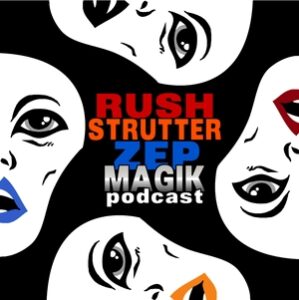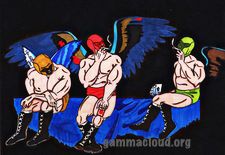 Originally written in late 2009
Originally written in late 2009
I first heard of Saul Alinsky’s book Rules for Radicals, a primer on community organizing, during a job interview some years ago. It was an informal interview over lunch with a couple of guys I had known for some time. At one point, one of the guys questioned my decision to leave the position I held at the time, citing the first rule from Rules for Radicals: “Change comes from within.” It was an interesting strategy, ostensibly aimed at drawing out my true reasons for wanting to move on to a new phase in life.
Alinsky’s Rules for Radicals was first published back in 1971, and how one views the book is likely colored by his or her politics. The salient point of this or any other rubric for revolutionary change is fundamental: To shake up the system requires a radical plan and radical action. This is true if you’re storming the barricades or marching down Main Street. It’s true whether you’re fighting for page views on a legitimate Internet forum or you’re crawling out of a literary cesspool to build a better web site. It’s true if you’re an industry giant or a young upstart. Given the latter context, I respectfully submit that the wrestling industry could use a hint of radicalism.
Is World Wrestling Entertainment a giant, lumbering, corporate dinosaur that’s out of touch with its fan base? Is the front office more enamored with merchandising and the ability to turn a quick buck than with the many time-honored traditions of sports entertainment? Is TNA cursed with bad booking because of a chronic disconnect between talent and creative staff? Is ROH perpetually on the brink of collapse? All good questions, for sure. One thing that we do know is that it’s been proven time and again that pro wrestling can be compelling and worth the interest and hard-earned money of fans while simultaneously being marketable and profitable. With this in mind, it seems clear that some radical changes would surely be in order if we were to realistically expect pro wrestling to return to the former glory of decades past.
The popular perception of “radical’ change often evokes images of new, cutting-edge, out-of-the box approaches. Well, that’s good too. But for today, let’s start with the basics; Let’s talk about common sense and the real world.
Let’s, consider some of pro wrestling’s “Rules for Radicals.”
Rule I: You, the promoter, have to at least pretend like you give a damn.
What I mean here is that if you expect me to be interested in what you’re offering, I have to at least feel like it is as important to you as you’d like for it to be to me. Anybody who knows me in real life (outside of cyberspace, that is) know that I live by this very principle. In the ring, it’s called “selling.” Outside of the ring, there are all kinds of fancy-schmantzy marketing terms when it comes to marketability of a product or event (for more on that see Rule IV). But for pro wrestling in general, most of the issue here boils down to storytelling. I’ll be the first to admit that there are certain words that I might overuse from time to time in my writing and “compelling’ is surely one of them. But it’s still a good fit here.
Let’s look at, say, the current state of the Divas division on Monday Night Raw. This is an area that the writers could obviously care less about, so why should viewers care on iota about who beats whom or which woman is wearing the belt at any given time? WWE has at their disposal a plethora of ostensibly talented female performers who are thrown into matches and programs with minimal fanfare or setup and—if we’re lucky—storylines often end either anticlimactically or abruptly. So as an answer to my earlier question of why we should care, I’ll just respectfully submit a simple counterpunch: We don’t care. Could the Divas division be better? Absolutely. But so long as WWE doesn’t care to push these women as anything other than objectified eye-candy (while motivating and training them to be better in-ring performers), there’s not much reason for us to give a damn.
Commentary is an extremely important area in this discussion. Even the best play-by-play guys are hard pressed to keep turning lemons into lemonade after a while. The one-dimensional commentary of folks like Michael Cole is almost a separate issue. Some things just plain wear him over time. For example: How many times in the past year have we heard Jerry Lawler describe something that happened on Raw as the “worst thing” he’s ever seen? It’s what Milhouse Van Houten meant when he exclaimed, “I’ve said ‘jiminy jillikers’ so many times the words have lost all meaning!..” Hyperbole can be effective when it’s not overused. Just like J.R.’s great quips and one-liners, though, these kinds of things can’t sell the action or the story. They can only enhance them. When a commentator’s trademarks become formulaic, they’re not selling anything; they’re just punching the clock and collecting a check.
Rule II: Fans can handle more than you might think.
 A long, long time ago, there used to be something called kayfabe. We old timers like to call those good old days the 1980’s. But Woody Guthrie was right when he paraphrased Bhudda: “All things are transient, fleeting and destined to pass away…” Such is the kayfabe. I’ve always thought of wrestling’s flexible reality as two sides of a plane that become a Möbius strip at a point. It’s this point at which flexible reality meets the suspension of disbelief. But I get it: Times change and so changes the industry. But what’s left in wrestling now’”particularly WWE’”is an implausibly fluid-like replacement in which history is shaped solely by the immediate needs of the present. Reality twists and bends at will, history and tradition be damned. Let’s call it all it flexfabe.
A long, long time ago, there used to be something called kayfabe. We old timers like to call those good old days the 1980’s. But Woody Guthrie was right when he paraphrased Bhudda: “All things are transient, fleeting and destined to pass away…” Such is the kayfabe. I’ve always thought of wrestling’s flexible reality as two sides of a plane that become a Möbius strip at a point. It’s this point at which flexible reality meets the suspension of disbelief. But I get it: Times change and so changes the industry. But what’s left in wrestling now’”particularly WWE’”is an implausibly fluid-like replacement in which history is shaped solely by the immediate needs of the present. Reality twists and bends at will, history and tradition be damned. Let’s call it all it flexfabe.
It might seem I’m picking on WWE here, but since they are, for all intents and purposes, the face of pro wrestling on a global scale, one can effectively argue that their philosophies and practices influence the entire industry. This is why their revisionist approach to the history of the business is so important. WWE seems to cater only to the short term memories of fans, encouraging us in an almost Orwellian sense to forget that there are other promotions, other styles and other markets which transcend their product.
They even apply implicit and explicit forms of revisionism to their own product, both by omission or by blatant re-telling or repackaging important facts and events on the fly. Consider Michael Cole’s comment during a recent episode of Raw in which he noted that Triple-H and John Cena had only competed against each other something like four or five times in the past. Knowing what I do about the wrestling business, I have to say that I find that to be a wildly implausible claim, whether it’s intended to be kayfabe or not. Surely there have been a number of house shows and dark matches in which these superstars have met time and again over the years. So why feed us a complete line of bull? Hell, I would have received it better if Cole had referred to this as their fourth televised match or something comparable. But at the end of it all, even when you spray paint a dog turd gold, it’s still a dog turd.
Continuity and history can make stories more interesting. WWE has a wealth of talent and history at its disposal in the likes of J.R. and Jerry Lawler, but they don’t talk much history in their play by play. Every so often, J.R. might hearken back to the days of Stone Cold and the Attitude Era or Lawler might slip in a reference to his mentor Jackie Fargo, but by and large, it seems like these kinds of reminiscences are frowned upon by Vince and Company. Even Matt Striker is more or less a proven authority on pro wrestling; a virtual talking encyclopedia, if you will. The setup is easy with guys like these: The play-by-play guy could easily ask the color commentator to recount a story about a similar confrontation or to compare the current in-ring action to a match or feud from yesteryear. Former football players and coaches turned broadcast journalists do it all the time. But instead, we get the tired old questions like, “What must be going through his mind right now?”
TNA and independent promotions are much better about acknowledging the histories and achievements of individual wrestlers and teams alike. ROH made a point to note that C.M. Punk and Samoa Joe were both alumni of the promotion when they each captured the titles for their respective promotions in 2008. At some level, this could easily be dismissed as self-promotion but at the same time it is an important nod to pro wrestling as having a real historical canon. TNA lists and recognizes all of Team 3-D’s titles or when they welcome veterans back as “former World Champions,” publicly acknowledging the fact that there are other promotions and other championships, they’re clearly of the mind that and pay attention to details and that they can handle life beyond the confines of the one specific “universe”.
Rule III: Substance makes the style but style very rarely makes the substance.
Confused? This is a simple point, really. Even if you have more pyro than Chinese New Year, a great entrance theme and a snazzy costume you’re still not even halfway there. The gimmick doesn’t make the man. Just ask Portuguese Man O’ War, Max Moon, and The Ringmaster about this one.
Some folks—like, say, Bobby Lashley or Mark Henry have the ability but they still require a little more polish or a little more practice when it comes to mic skills or presentation. When a particular personality or team is forced on fans prematurely, the backlash has the potential to taint a wrestler’s career for years after. Then there are those few folks seem to develop an “x factor” which brings about the ideal balance of talent with ability. It’s these ingredients that make a push necessary to elevate performers to “main event status.”
Sometimes the push doesn’t come, though. In Rob Van Dam’s case, everything clicked and the moment was right, but the push was aborted due to external factors. It’s equally regrettable when internal factors interfere in the natural evolution of a performer’s career. Shelton Benjamin can certainly attest to the fact that years of on again-off again angles and campaigns seem have taken a toll on his career.
On a good day, Shelton is a midcard mainstay, but the fact that he has never quite broken into the top tier of the card is not for lack of effort or talent on his part. Rather, it’s a reflection on the WWE’s inability and/or refusal to recognize what Benjamin brings to the table and consistently present it to the fans in a way that truly showcases his talent. Benjamin’s occasional “jobs” at the bottom of the card haven’t done anything to help his credibility with the masses of WWE’s fan base, either. At least he has good company with Charlie Haas, though.
Love them or hate them, there are plenty of legends who have enjoyed the glam and flash of a big time push while working with virtually every fiber of their being to be the best at what they do. Bret Hart and Shawn Michaels had, at different points in their careers, the entire force of the industry behind them as they rose to the top of the international scene. Chris Jericho has showed time and again that it’s not the package or the angle that sustains him and lends him the credibility to succeed. It’s his determination and dedication to his job that makes him as an industry leader. Even John Cena, who might still accurately be called one of the most controversial WWE champions of all time, knows how to work a match and how to work a crowd.
What promotions and writers need to understand is that the fireworks and music are just a few seconds long. Once a wrestler’s on the mat or on the mic, it’s up to him (or her) to deliver the goods.
Rule IV: Just because people tune in or buy a product doesn’t mean it’s worth a crap.
John Cena was right when—after the Bragging Rights Iron Man contest—he declared that the Orton vs. Cena feud “had to end.” It’s too bad the inevitability of this hadn’t dawned on anyone sooner. Back in 2007, “Orton versus Cena” had the makings of an epic conflict. The potential of it all was easy to see from the beginnings of their respective singles pushes. Cena had risen to fame in 2005, getting the huge payoff from JBL’s year-long WWE title reign. Orton finally stepped out of Evolution’s shadow and became his own man in 2004, further reinventing himself again in 2006 and 2007.
WWE dropped hints here and there about what was to come. The elements were there, but everything came to a screeching halt when Cena sustained a major injury smack in the middle of the white-hot feud. It was on again, off again, and each time the battle was rejoined it became tougher to recover that steam, interest, and momentum.
It’s likely that Cena’s “it had to end” sentiment was intended to channel the feelings of frustrated fans rather than those of WWE Creative, because I have little doubt that they could’ve easily dragged it our for another year or two. A TLC, Punjabi Prison match, an arm wrestling contest…Someone should stop the madness!” you say? To that I respectfully reply, “You and what army?”
Each WWE and TNA pay per view event nets more revenue than many people might make in their entire lives. Then again, the same might be said for a well-constructed Ponzi scheme or the latest “miracle cure.” Let’s keep it real for a second here: Wrestling fans are just as culpable as owners and writers when it comes to the statue of pro wrestling today. All too often we just decide to take what’s being offered because it’s a quick fix or the only game in town. So long as the bottom line is written in black, the powers that be will likely stay the course.
There will be lackluster shows or poorly conceived, “gimmick” pay per views from time to time, but a steady diet of them should indicate a problem at both ends. People tune in for all kinds of reasons, including just to see how bad a particular event might prove to be. The old “train wreck” cliché helps to explain things like the title run of, say, The Great Khali or Kathy Lee Gifford’s return to daytime television.
There’s something to be said for the folksy wisdom of Thomas Tusser who said “A fool and his money are soon parted.” As fans, we have to send the message to promoters that we want to see something different if we don’t like what we’re getting month after month.
“We’re waiting for the dinosaurs to die out. They will die. And then we’ll move into their homes.”
—Kurt Cobain
If you could hop in a time machine, travel back to 1983, and tell a 10 year-old version of me that almost three decades in the future, my kid would have no concept of the omnipresent threat of nuclear war, I’d say, “Where in the hell did you get a time machine?” I would also have a hard time believing that in the space of a few short decades, the geopolitical landscape would be so dramatically altered as it is today. And yet it happened. Things changed. Huge things.
In the grand scheme of things, wrestling is kinda, sorta not that big of a deal. Not as big as, say, the fate of every human being on the face of the earth, right? Still, WWE might be a billion dollar global enterprise, but VKM and his crew could do well to learn a bit from the lessons of history.
This rule is ultimately a simple one. The main points of the preceding rules more or less build to this: When the business becomes old, bloated, and no longer relevant, it will be in its death throes. There was some truth to Paul Heyman’s old shoot promo on SmackDown about how Vince McMahon reneged on his pledge to leave the territories alone.
Vince made the WWE by assimilating and absorbing what he could use and casting everything else into the dustbin. In some ways, it was a campaign of self-preservation; A kind of “do it to them before they do it to you” mentality in the beginning. As WWF grew and Vince became battle hardened and business savvy, he learned the important lessons that would prepare him for a head-to-hear with Ted Turner. It was this experience that ultimately defined WWE as the corporate behemoth that it is today. But pop culture is in a state of eternal flux. It’s true there are certain “cycles” that bring back “retro” material from time to time, but generally speaking, pro wrestling—itself a microcosm of pop culture as a whole—tends to need to move forward as tastes, cultural norms and standards change.
The problem right now is that the big promotions (WWE and TNA) apply these principles in a piecemeal fashion. Changes are made here and there, but the better part of attention is on the marketability of the moment (remember flexfabe from Rule II) and not the staying power that one might have by adopting an all-sided approach that embraces sports entertainment as a phenomenon with real history and real continuity.
The real canon, then, should be fundamental and indisputable. I’m not talking about a “The Story of Pro Wrestling According to Vince” coffee table volume that you can buy at the WWE ShopZone. I’m talking about a real, unified fabric of wrestling history that promoters and writers can study, embrace, and use to plan for the future. For those of us who have followed wrestling and truly loved and appreciated it for the better part of our respective lives, it’s the big picture that sustains us and retains us as fans, year after year and generation to generation.
Without the fans—without the customers—pro wrestling may as well be that lumbering behemoth who is just looking for a place to die quietly.
Nothing is forever. Just ask the dinosaurs. ★
The opinions expressed within this column are solely those of Mike Bessler. On a really bad day, Mike might well accuse others of conspiring to use his own opinions against him in some kind of bizarre, hypno-voodoo ritual in which he is turned into some kind of mindless zombie who is paralyzed by a kind of infinity loop in which he questions the validity of his own thoughts and wonders if he has imagined reality itself while simultaneously pontificating the possibility that time and space are the dreams of imagination of some larger universal mind or sentiment being. Most of the time, he just accepts things as they are, though. Any complaints should be made directly to Branko Broz if you can still find him. Unfortunately, Branko can only check his e-mail on Thursday nights and Sunday mornings because Aunt Mirjana totally hogs the WebTV.










